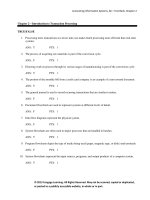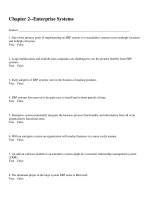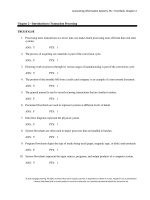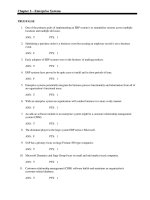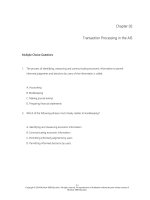Guide to operating systems 4th edition palmer test bank
Bạn đang xem bản rút gọn của tài liệu. Xem và tải ngay bản đầy đủ của tài liệu tại đây (142.65 KB, 7 trang )
Chapter 02
TRUE/FALSE
1. The first true 32-bit operating system developed by Microsoft was Windows 3.1.
ANS: F
PTS: 1
REF: 58
2. Windows 95 used cooperative multitasking for 16-bit applications and preemptive multitasking for
32-bit applications.
ANS: T
PTS: 1
REF: 60
3. Windows 98 was the first Windows OS to use the Kerberos security system.
ANS: F
PTS: 1
REF: 63
4. The advanced firewall in Windows Vista monitors incoming communications only.
ANS: F
PTS: 1
REF: 79
5. Mac OS X allows multiple users to access the OS in their own workspaces.
ANS: T
PTS: 1
REF: 106
MULTIPLE CHOICE
1. Which of the following OSs was the first to offer true 32-bit functionality?
a. MS-DOS
c. Windows 95
b. Windows 3.1
d. Windows 98
ANS: C
PTS: 1
REF: 58
2. If you suspect that a Windows problem is related to the database that stores hardware and software
configuration information, which Windows component should you investigate?
a. ActiveX
c. Component Object Model
b. Plug and Play
d. Registry
ANS: D
PTS: 1
REF: 60
3. Which of the following features differentiated Windows NT from Windows 95/98?
a. Windows NT supported plug and play
c. Windows NT had a GUI
b. Windows NT’s kernel ran in privileged
d. Windows NT had built-in network support
mode
ANS: B
PTS: 1
REF: 62
4. Which of the following is NOT a feature of the Windows NT security model?
a. file and folder protection
c. all network data is encrypted
b. user accounts and passwords
d. support for domains
ANS: C
PTS: 1
REF: 62
5. Which of the following is NOT a feature first introduced in Windows 2000?
a. user accounts and passwords
c. Kerberos
b. Active Directory
d. IntelliMirror
ANS: A
PTS: 1
REF: 62-63
6. You need to set up a new network with 15 workstations. You must provide access to network
services for all 15 stations simultaneously and you have been told to use Active Directory in this
network. Which OS should you use?
a. Windows 2000 Professional
c. Linux
b. Windows 2000 Server
d. Mac OS Server
ANS: B
PTS: 1
7. From which OS did Windows XP evolve?
a. Windows 98
b. Windows ME
ANS: C
PTS: 1
REF: 64
c. Windows 2000
d. Windows Server 2003
REF: 66
8. Which of the following features was first available in Windows Server 2003 and Windows XP?
a. 64-bit Itanium support
c. Kerberos authentication
b. Active Directory
d. Component Object Model
ANS: A
PTS: 1
REF: 67, 69
9. You have a network of 175 workstations, 5 servers, and 12 printers. You want to be able to maintain
enterprise-wide control of your network printers from one location. What new tool in Windows
Server 2003 R2 can help you do that?
a. Group Policy
c. Print Management Console
b. MMC 3.0
d. Printer and Queue Management
ANS: C
PTS: 1
REF: 72-73
10. You’re running several Windows Server 2003 R2 servers. You re considering purchasing an
application that requires user authentication and authorization. You want to be able to manage your
user accounts through a single database that will work both for centralized logon and for this
application. What feature should you consider using?
a. ADAM
c. COM
b. DFS
d. MOM
ANS: A
PTS: 1
REF: 75
11. You’re an administrator for a network with 6 Windows Server 2003 R2 servers. You maintain shared
files on four of those servers and your users frequently get confused as to which server holds which
share. You want to simplify access to the shares on these servers. What feature can you use?
a. MOM
c. ADAM
b. ADFS
d. DFS
ANS: D
PTS: 1
REF: 77
12. File Server Resource Manager offers which of the following features?
a. common hierarchy for file shares
c. quota management
b. single sign-on
d. dynamic systems initiative
ANS: C
PTS: 1
REF: 78
13. You have created a number of different documents using several applications including Word, Excel,
and PowerPoint. These files are located in different folders on your hard drive. You want to be able
to access these folders from a single location without actually moving them from their current location.
What feature of Windows Vista can you use?
a. distributed file system
c. virtual folders
b. DSI
d. file server resource manager
ANS: C
PTS: 1
REF: 85
14. Which of the following will be launched automatically if Vista detects a problem while booting the
system?
a. Restart Manager
c. Service-failure Recovery
b. Microsoft Update
d. Startup Repair Tool
ANS: D
PTS: 1
REF: 86
15. Which Windows Vista feature protects the registry and specific folders so that their contents are only
available to a specific user?
a. UAP
c. Systems Management Server
b. IPSec
d. GPMC
ANS: A
PTS: 1
REF: 88
16. Which new feature in Windows Server 2008 allows you to run multiple independent operating systems
on a single physical server?
a. failover clustering
c. Hyper-V
b. Server Core
d. Server Manager
ANS: C
PTS: 1
REF: 91
17. You want to be able to take advantage of the new Server Core feature. You have both 32-bit and
64-bit computers you want to install Server Core on. Which Windows OS should you purchase?
a. Windows Server 2003 R2
c. Windows Server 2008 R2
b. Windows Server 2008
d. Windows Server 2008 Core Edition
ANS: B
PTS: 1
REF: 91-92
18. You are the administrator for a company that has users that must access the network remotely on a
regular basis. You want the remote connection to be secure and as easy as possible to set up for your
users. What new feature found in Windows Server 2008 R2 along with Windows 7 can you use to
accomplish this?
a. DirectAccess
c. FCI
b. BranchCache
d. MMC 3.0
ANS: A
PTS: 1
REF: 94
19. What feature in Windows 7 uses flash memory to supplement RAM?
a. DirectAccess
c. BranchCache
b. Bluetooth
d. ReadyBoost
ANS: D
PTS: 1
REF: 97-98
20. What component of a Linux/Unix OS functions similar to a MS-DOS command prompt?
a. X Window
c. shell
b. Gnome
d. NFS
ANS: C
PTS: 1
REF: 102
COMPLETION
1. _____________ enables the operating system to automatically detect newly installed hardware.
ANS:
plug and play
PnP
PTS: 1
REF: 59
2. A technique in which two or more servers are linked to equally share the server processor load is
called _______________.
ANS: clustering
PTS: 1
REF: 64
3. _________________ was a new feature in Windows Server 2003 that allows companies to secure their
documents from copying, forwarding, and printing.
ANS:
rights management service
RMS
PTS: 1
REF: 70
4. You can limit the amount of space users can use on a volume by setting __________.
ANS: quotas
PTS: 1
REF: 78
5. Mac OS supported a peer-to-peer networking protocol called _________ until Mac OS X Snow
Leopard.
ANS: AppleTalk
PTS: 1
REF: 105
MATCHING
a.
b.
c.
d.
e.
ADFS
clustering
domain
Hyper-V
IPsec
f.
g.
h.
i.
j.
privileged mode
Server Core
storage area network
virtual folder
task supervisor
1. A logical grouping of computers and computer resources that helps manage these resources and user
access to them
2. Allows a server to run multiple independent operating systems at the same time along with running
multiple virtual servers on one physical server
3. A scaled-back version of Windows Server 2008 where all configurations and
maintenance are done via the command-line interface
4. The ability to share the computing load and resources by linking two or more
discrete computer systems to function as though they are one
5. A set of storage devices that appear to the server as being locally attached, but in fact are on their own
network with access granted to the server
6. Enables single sign-on for both network and Web-based resources
7. A combination of folders and files based on content. The files can be in any
location on the local computer or the network
8. A way to secure Internet protocol (IP) traffic by encrypting and
authenticating each packet
9. A process in the operating system that keeps track of the applications that
are running on the computer and the resources they use
10. A feature of the operating system kernel introduced in Windows NT
which protected it from problems created by a malfunctioning program or process
1.
2.
3.
4.
5.
6.
7.
8.
9.
10.
ANS:
ANS:
ANS:
ANS:
ANS:
ANS:
ANS:
ANS:
ANS:
ANS:
C
D
G
B
H
A
I
E
J
F
PTS:
PTS:
PTS:
PTS:
PTS:
PTS:
PTS:
PTS:
PTS:
PTS:
1
1
1
1
1
1
1
1
1
1
REF: 109-111
SHORT ANSWER
1. Describe the registry which was introduced in Windows 95.
ANS:
The registry is a hierarchical database that provides the following information:
• Operating system configuration
• Service and device driver information and configuration
• Software and application parameters
• Hardware configuration
• Performance information
• Desktop configuration
PTS: 1
REF: 60
2. Describe Active Directory - what it is, what it contains, and how it is organized.
ANS:
Active Directory is a database that is used to store information about resources such as user accounts,
computers, and printers. It groups resources at different levels (hierarchies) for local and universal
management. Active Directory also provides a centralized means to
quickly find a specific resource through indexing.
PTS: 1
REF: 63
3. What term can be defined as the sum of all the costs associated with purchasing, maintaining, and
supporting a product or service?
ANS:
total cost of ownership
PTS: 1
REF: 64
4. List three features found in Windows Server 2008 that are not found in Windows Server 2003 R2.
ANS:
Hyper-v virtualization
Self-healing NTFS
Server Core
Server Manager
PTS: 1
REF: 91
5. Briefly describe how DFS can make server resource access easier for users.
ANS:
The Distributed File System (DFS) enables you to simplify access to shared folders on a network by
setting up folders to appear as though they are accessed from only one place. This relieves users from
having to know the names of several different servers to access file shares that are located on a number
of servers.
PTS: 1
REF: 77
6. What feature can you use to prevent users from storing particular types of files on server volumes?
ANS:
File Screening Management
PTS: 1
REF: 78
7. Describe why you might want to use virtual folders.
ANS:
Consider a company in which Taylor Hanson has authored spreadsheets in one
shared folder, Word documents in another folder, and PowerPoint slides in still a different
folder. Taylor has the option to create a virtual folder that organizes all of the files she has
created using her name (author) as the basis for the virtual folder. In this way, when Taylor
wants to work on a particular file she has created, it is easy to find that file in her virtual
folder.
PTS: 1
REF: 85
8. List three new reliability features that became available starting with Vista.
ANS:
Startup Repair Tool
New code to prevent interruptions
Self-diagnosis for problems
Restart Manager
Service-failure recovery
PTS: 1
REF: 86
9. How can the Hyper-V feature be useful in the datacenter?
ANS:
Hyper-V virtualization can help keep operational costs as low as possible in both power consumption
and the purchase of new physical servers. Live Migration allows the server administrator to move a
virtual machine from one physical server to another with no service interruption.
PTS: 1
REF: 95
10. With respect to computer hardware, what is a major difference between Mac OS and Windows or
Linux?
ANS:
One significant difference between Mac OS and other operating systems is that only Apple makes
hardware capable of running Mac OS. Mac OS now runs on Intel processors, but the hardware is still
Apple hardware.
PTS: 1
REF: 105

